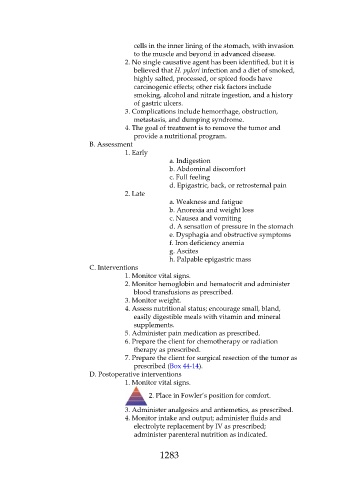Page 1283 - Saunders Comprehensive Review For NCLEX-RN
P. 1283
cells in the inner lining of the stomach, with invasion
to the muscle and beyond in advanced disease.
2. No single causative agent has been identified, but it is
believed that H. pylori infection and a diet of smoked,
highly salted, processed, or spiced foods have
carcinogenic effects; other risk factors include
smoking, alcohol and nitrate ingestion, and a history
of gastric ulcers.
3. Complications include hemorrhage, obstruction,
metastasis, and dumping syndrome.
4. The goal of treatment is to remove the tumor and
provide a nutritional program.
B. Assessment
1. Early
a. Indigestion
b. Abdominal discomfort
c. Full feeling
d. Epigastric, back, or retrosternal pain
2. Late
a. Weakness and fatigue
b. Anorexia and weight loss
c. Nausea and vomiting
d. A sensation of pressure in the stomach
e. Dysphagia and obstructive symptoms
f. Iron deficiency anemia
g. Ascites
h. Palpable epigastric mass
C. Interventions
1. Monitor vital signs.
2. Monitor hemoglobin and hematocrit and administer
blood transfusions as prescribed.
3. Monitor weight.
4. Assess nutritional status; encourage small, bland,
easily digestible meals with vitamin and mineral
supplements.
5. Administer pain medication as prescribed.
6. Prepare the client for chemotherapy or radiation
therapy as prescribed.
7. Prepare the client for surgical resection of the tumor as
prescribed (Box 44-14).
D. Postoperative interventions
1. Monitor vital signs.
2. Place in Fowler’s position for comfort.
3. Administer analgesics and antiemetics, as prescribed.
4. Monitor intake and output; administer fluids and
electrolyte replacement by IV as prescribed;
administer parenteral nutrition as indicated.
1283

